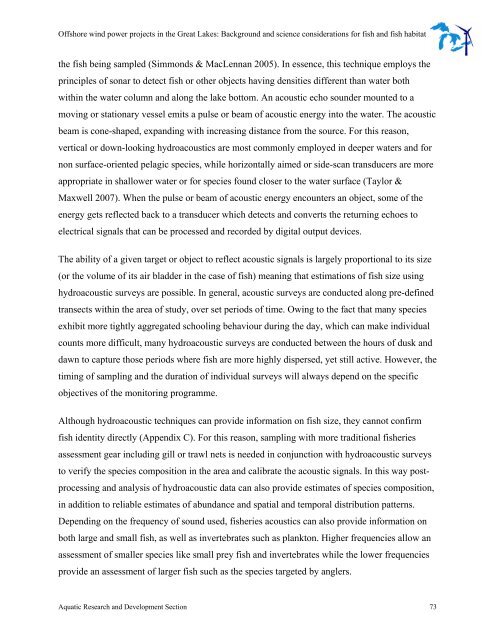Offshore Wind Power Projects in the Great Lakes - Ministry of ...
Offshore Wind Power Projects in the Great Lakes - Ministry of ...
Offshore Wind Power Projects in the Great Lakes - Ministry of ...
You also want an ePaper? Increase the reach of your titles
YUMPU automatically turns print PDFs into web optimized ePapers that Google loves.
<strong>Offshore</strong> w<strong>in</strong>d power projects <strong>in</strong> <strong>the</strong> <strong>Great</strong> <strong>Lakes</strong>: Background and science considerations for fish and fish habitat<br />
<strong>the</strong> fish be<strong>in</strong>g sampled (Simmonds & MacLennan 2005). In essence, this technique employs <strong>the</strong><br />
pr<strong>in</strong>ciples <strong>of</strong> sonar to detect fish or o<strong>the</strong>r objects hav<strong>in</strong>g densities different than water both<br />
with<strong>in</strong> <strong>the</strong> water column and along <strong>the</strong> lake bottom. An acoustic echo sounder mounted to a<br />
mov<strong>in</strong>g or stationary vessel emits a pulse or beam <strong>of</strong> acoustic energy <strong>in</strong>to <strong>the</strong> water. The acoustic<br />
beam is cone-shaped, expand<strong>in</strong>g with <strong>in</strong>creas<strong>in</strong>g distance from <strong>the</strong> source. For this reason,<br />
vertical or down-look<strong>in</strong>g hydroacoustics are most commonly employed <strong>in</strong> deeper waters and for<br />
non surface-oriented pelagic species, while horizontally aimed or side-scan transducers are more<br />
appropriate <strong>in</strong> shallower water or for species found closer to <strong>the</strong> water surface (Taylor &<br />
Maxwell 2007). When <strong>the</strong> pulse or beam <strong>of</strong> acoustic energy encounters an object, some <strong>of</strong> <strong>the</strong><br />
energy gets reflected back to a transducer which detects and converts <strong>the</strong> return<strong>in</strong>g echoes to<br />
electrical signals that can be processed and recorded by digital output devices.<br />
The ability <strong>of</strong> a given target or object to reflect acoustic signals is largely proportional to its size<br />
(or <strong>the</strong> volume <strong>of</strong> its air bladder <strong>in</strong> <strong>the</strong> case <strong>of</strong> fish) mean<strong>in</strong>g that estimations <strong>of</strong> fish size us<strong>in</strong>g<br />
hydroacoustic surveys are possible. In general, acoustic surveys are conducted along pre-def<strong>in</strong>ed<br />
transects with<strong>in</strong> <strong>the</strong> area <strong>of</strong> study, over set periods <strong>of</strong> time. Ow<strong>in</strong>g to <strong>the</strong> fact that many species<br />
exhibit more tightly aggregated school<strong>in</strong>g behaviour dur<strong>in</strong>g <strong>the</strong> day, which can make <strong>in</strong>dividual<br />
counts more difficult, many hydroacoustic surveys are conducted between <strong>the</strong> hours <strong>of</strong> dusk and<br />
dawn to capture those periods where fish are more highly dispersed, yet still active. However, <strong>the</strong><br />
tim<strong>in</strong>g <strong>of</strong> sampl<strong>in</strong>g and <strong>the</strong> duration <strong>of</strong> <strong>in</strong>dividual surveys will always depend on <strong>the</strong> specific<br />
objectives <strong>of</strong> <strong>the</strong> monitor<strong>in</strong>g programme.<br />
Although hydroacoustic techniques can provide <strong>in</strong>formation on fish size, <strong>the</strong>y cannot confirm<br />
fish identity directly (Appendix C). For this reason, sampl<strong>in</strong>g with more traditional fisheries<br />
assessment gear <strong>in</strong>clud<strong>in</strong>g gill or trawl nets is needed <strong>in</strong> conjunction with hydroacoustic surveys<br />
to verify <strong>the</strong> species composition <strong>in</strong> <strong>the</strong> area and calibrate <strong>the</strong> acoustic signals. In this way postprocess<strong>in</strong>g<br />
and analysis <strong>of</strong> hydroacoustic data can also provide estimates <strong>of</strong> species composition,<br />
<strong>in</strong> addition to reliable estimates <strong>of</strong> abundance and spatial and temporal distribution patterns.<br />
Depend<strong>in</strong>g on <strong>the</strong> frequency <strong>of</strong> sound used, fisheries acoustics can also provide <strong>in</strong>formation on<br />
both large and small fish, as well as <strong>in</strong>vertebrates such as plankton. Higher frequencies allow an<br />
assessment <strong>of</strong> smaller species like small prey fish and <strong>in</strong>vertebrates while <strong>the</strong> lower frequencies<br />
provide an assessment <strong>of</strong> larger fish such as <strong>the</strong> species targeted by anglers.<br />
Aquatic Research and Development Section 73
















